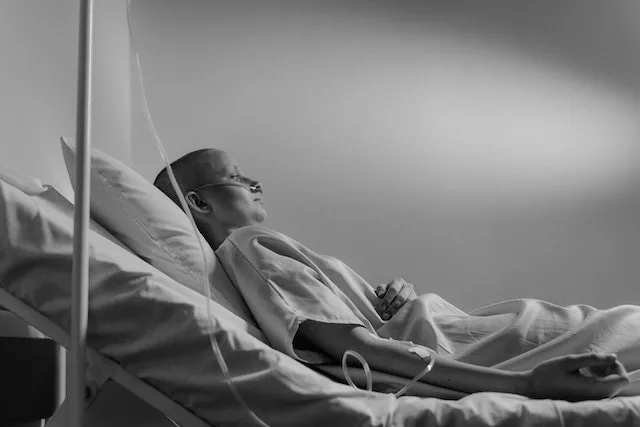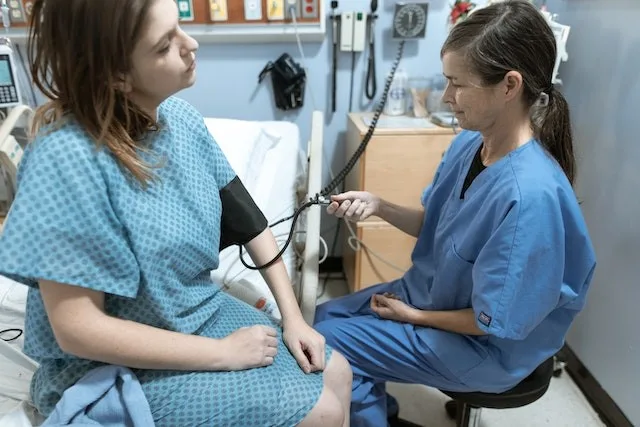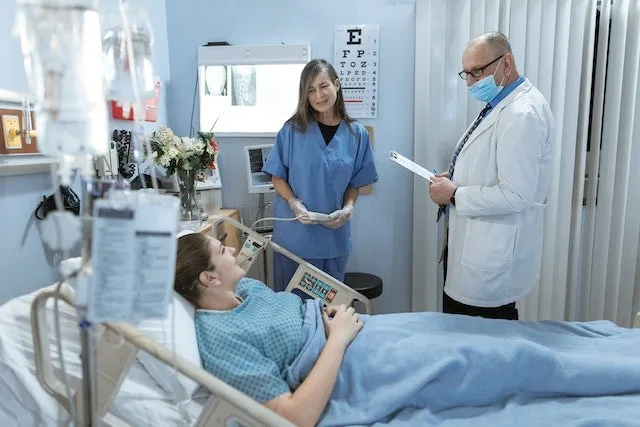Table of Contents
A Hospital patient gown represents a patient’s journey towards healing. With all the decor and environment that the hospital provides, to keep the patient comfortable and at ease. This is one of the main components.
Hospital patient gown, made from cotton or cotton blend fabric, are designed to prioritize patient comfort and preserve their dignity. The hospital patient gown, typically made from soft, breathable fabrics, provides comfort during extended periods of wear.
I am Mohammed Ibrahim Anwar from Chennai India. I have been making a living and sharing my experience and knowledge in the field of textile and apparel with people since 1997. For more information about me, please visit my About Us page.
This blog post serves as an extension of my previous article on types of uniforms, where you may understand various uniforms used in various industries and sectors. In this post, I will provide additional information on the different types of gown and fabrics commonly used in hospital patient gown.
By the end of this post, you will have a deeper understanding of hospital patient gown, including the fabric, content, stitch, and product details. These factors play a crucial role in providing comfort and functionality to patients. Let’s dive in for loads of knowledge.
A Stitch in Time: Crafting Specialized Hospital Patient Gown
The Art of Tailoring Patient Gowns for Specific Medical Treatments
Hospital patient gown, play a crucial role in providing comfort and ease of access during medical procedures. These gowns are carefully cut and stitched to ensure the best fit and functionality. The content of the gowns is designed to prioritize patient comfort and convenience.
The ideal fabric GSM that could be used for hospital patient gown is between 150 to 220 GSM. In 100% Cotton or Cotton blend fabric.
Customized hospital gowns, with the hospital branding and color help to provide a better environment for patients, ensuring their comfort throughout their stay. These unisex gowns are designed with attention to product details and offer additional information to meet the specific needs of each patient.
Tailored Designs Ensure Patient Comfort During Medical Procedures
Specialized patient gowns, made from comfortable fabric, are designed with the patient’s comfort in mind. The product details of these unisex gowns include a unique code for easy identification. They feature innovative design elements that allow for easy movement and flexibility while maintaining modesty.
For example, some patient uniforms made of fabric have adjustable closures or snaps to accommodate different body shapes and sizes. These product details are essential when choosing the right code for medical gowns.
These patients’ clothes are shortmade designs take into consideration the type of medical procedure being performed. For instance, when considering patient uniforms, surgical dress for patients may have reinforced areas where incisions are made to prevent tearing or contamination. These patient uniform product details often include a specific code for easy identification.
Specialized Gowns Offer Easy Access for Healthcare Professionals
Healthcare professionals require quick and easy access to patients’ bodies during examinations, treatments, and surgeries. This is why having the right isolation gowns is crucial and providing all the necessary product details to healthcare professionals to make informed decisions.
The need to incorporate features such as strategically placed openings or flaps that allow healthcare providers to perform necessary procedures without having to remove the entire gown. These gowns are designed with specific product details in mind, ensuring easy access and convenience for medical professionals.
This accessibility code not only saves time but also maintains the dignity of patients who may already be feeling vulnerable due to their medical condition. It ensures that product details are easily accessible and convenient for all users. It enables healthcare professionals to deliver efficient care while respecting patient privacy with the help of advanced code and product details.

Pediatric Perfection: Hospital Gowns Designed for Young Patients
Unique Features and Considerations in Pediatric Patient Gowns
Pediatric patient gowns are specially designed to cater to the unique needs of young patients during their hospital stay. Child-friendly patterns and colors, play a crucial role in alleviating anxiety and creating a more positive environment for young patients. By incorporating fun and engaging designs, hospitals can transform the hospital experience for kids.
To ensure a perfect fit, pediatric patient gowns come in smaller sizes compared to adult gowns. These smaller sizes are designed specifically for pediatric patients. The patient’s clothes adjustable features, such as snaps or ties, allow healthcare professionals to customize the gown’s fit based on the child’s age, size, and medical condition.
In addition to their playful appearance, these specialized gowns also address practical concerns specific to younger patients by providing comprehensive product details. Patient uniforms often feature reinforced seams to withstand the active movements common among children. These product details ensure the durability and longevity of the garment. As required by the hospitals patient uniform designs even incorporate pockets or Velcro closures for added convenience.
By implementing pediatric patient gowns, hospitals create an environment that is more conducive to healing and recovery for young patients. These specialized patient uniforms not only provide comfort but also contribute positively to a child’s emotional well-being during their hospital stay.

Geriatric Comfort: Tailored Gowns for Elderly Patients
Adapting Hospital Gowns to Meet the Needs of Geriatric Patients: Enhancing Product Details for Better Comfort and Functionality
Geriatric patients have unique needs. These patients’ clothes are specially designed to address the mobility challenges that older individuals may face.
Mobility-Friendly Design
Geriatric hospital gowns prioritize ease of movement. They feature adaptive closures that make dressing a patient easier for the elderly with limited dexterity. These closures, such as Velcro or snap buttons, eliminate the need for intricate fastening and allow caregivers to dress patients more efficiently.
Enhanced Comfort
Comfort is a crucial aspect of geriatric gown design. Soft and breathable fabrics are used in patient uniforms to prevent skin irritation and promote overall comfort.
The fabric choice ensures that patients can wear the gowns for extended periods without discomfort or overheating.
The ideal fabric that could be used would be cotton or cotton-blend fabric that is soft to the touch and gentle on the skin.
Maintaining Dignity
Maintaining dignity is essential for elderly patients and geriatric gowns take this into account through modesty features in their design. These features include full coverage at the back, ensuring that patients feel secure and comfortable during examinations or procedures.
Unisex Design
Geriatric hospital gowns typically come in a unisex design, accommodating both male and female patients equally. This approach eliminates any potential discomfort or embarrassment related to gender-specific patient uniform designs.
The Role of Quality Fabrics: Ensuring Comfort in Hospital Gowns
How Fabric Choices Impact the Comfort of Patient Gowns
Fabric choices play a vital role in determining the comfort level of patient uniforms, such as hospital gowns. High-quality fabrics contribute significantly to patient satisfaction during their stay.
Moisture-wicking materials are essential for keeping patients dry and comfortable throughout the day. These patient dress male and patient dress female are made with fabrics that have the ability to draw moisture away from the body, preventing sweat and allowing air circulation. As a result, patients feel fresher and more at ease.
Fabrics that are made out of natural fibers and a combo of natural and synthetic fibers are best suited for hospital patient gown. The end product has to be soft, breathable, and light. So that it’s comfortable on the skin and easy to maintain.
Antimicrobial properties are another crucial factor. In a healthcare setting, where infections can easily spread, using fabrics with antimicrobial properties helps reduce the risk of infections. These fabrics inhibit the growth of bacteria and other harmful microorganisms, creating a safer environment for patients.
There are natural antimicrobial fabrics like Bamboo, Linen, and wool. Having hospital gown for patients in these fabrics has natural antimicrobial properties for the life of the garment. They are on the higher side with regard to price but give a natural solution to antimicrobial features.
Softness is key for patient comfort, especially for individuals with sensitive skin or allergies. Hypoallergenic fabrics minimize skin irritation and allergic reactions that may arise from prolonged contact with clothing materials. By using soft and gentle fabrics, hospitals can ensure that patients’ comfort levels are maximized.
Color Psychology in Healthcare: How Gown Colors Impact Patient Wellbeing
Understanding the Significance of Gown Colors for Different Treatments
The color of a hospital patient gown may seem like a small detail, but it can have a significant impact on a patient’s well-being. Healthcare providers are increasingly recognizing the importance of color psychology in creating a positive and calming environment for patients. Here’s how different gown colors can influence the patient’s experience:
Calming colors like blue or green can promote relaxation and reduce stress levels. Blue is often associated with feelings of tranquility and serenity, while green symbolizes nature and harmony. These hues have been found to have a soothing effect on patients, helping them feel more at ease during their hospital stay.
Brighter hues create a positive environment that uplifts the patient’s mood. Vibrant colors like yellow or orange can evoke feelings of happiness and energy. They can help brighten up the hospital setting and create a cheerful atmosphere, which may contribute to improved patient morale.
Different color options allow personalization based on individual preferences or cultural beliefs. Recognizing that patients have diverse backgrounds and needs, hospitals now offer an array of gown colors to choose from. This allows patients to select shades that align with their personal style or cultural traditions, fostering a sense of identity and comfort.
Patient-centered care considers color psychology when selecting hospital gown shades. Hospitals strive to provide patient-centered care by taking into account various factors that impact patient well-being. Color psychology plays an essential role in this approach, as healthcare providers aim to create an environment that promotes healing and enhances the overall experience for patients.
Front Open Gowns: Enhancing Accessibility for Patients
Exploring the Convenience and Purpose of Front-Open Hospital Gowns
Front open gowns are designed to enhance accessibility and convenience for patients during medical examinations. These gowns have a unique feature that allows them to be easily opened at the front, eliminating the need for complete undressing.
Easy-to-use front open gowns facilitate medical examinations without complete undressing
When healthcare professionals need to examine or treat a patient, they can simply open the front of the gown instead of having the patient remove it entirely. This saves time and effort for both patients and medical staff, making the process more efficient.
Front opening allows convenient access to IV lines and other medical devices
One of the key advantages of front open gown for patients is that they provide easy access to important medical devices such as IV lines. With these gowns, healthcare professionals can perform necessary procedures without having to remove or reposition any equipment attached to the patient’s body.
Modesty is maintained while ensuring healthcare professionals can perform necessary procedures
Front open gowns for patients strike a balance between maintaining modesty for patients and enabling healthcare professionals to carry out their required procedures effectively. By exposing only the necessary areas, these gowns allow doctors and nurses to conduct examinations or administer treatments while respecting patient privacy.
Front open gowns promote patient comfort and streamline the care process
Wearing a front open gown can significantly improve patient comfort during hospital stays. These gowns are typically made from soft, breathable materials that enhance overall comfort levels. Their convenient design reduces unnecessary disruptions in a patient’s daily routine by minimizing dressing and undressing time.
In response to customer demand for improved accessibility and convenience, many hospitals now offer front open gowns as an alternative option alongside traditional back-tie gowns. The adoption of these innovative garments not only enhances patient satisfaction but also streamlines the care process for healthcare providers.
Behind the Scenes: Hospital Staff Dress Code and Gown Selection
How Hospital Staff Attire, Including Gowns, Contributes to Patient Care
Hospital staff dress code plays a crucial role in ensuring a professional appearance for healthcare providers. This not only instills confidence in patients but also helps maintain a sense of order and professionalism within the healthcare setting.
Gown selection is an essential aspect of hospital staff attire, especially. Strict protocols are followed to ensure that gowns contribute to maintaining a sterile environment. By wearing appropriate gowns, healthcare professionals can minimize the risk of cross-contamination between patients.
When choosing gowns for different medical procedures, hospital staff adhere to specific guidelines. These guidelines take into consideration factors such as the level of protection required, ease of use, and patient accessibility.
The proper usage of hospital gowns goes beyond just protecting patients from potential infections. It also helps create a positive patient experience by promoting dignity and comfort. When patients feel comfortable and respected during their hospital stay, it can have a positive impact on their overall well-being and recovery.

Maternity Matters: Hospital Gowns for Delivery and Postpartum Care
Maternity hospital gowns are specially designed to provide comfort and convenience for expectant mothers during and after delivery. These gowns offer a range of benefits that cater to the unique needs of pregnant women.
Specialized Gowns Designed for Expectant Mothers During and After Delivery
Hospital gowns for maternity purposes are tailored to meet the specific requirements of pregnant women throughout their childbirth journey. These gowns are equipped with various features that enhance comfort, accessibility, and functionality during labor, delivery, and postpartum care.
Comfortable Labor and Delivery Experience
Maternity hospital gowns prioritize comfort during labor and delivery. The fabric used is soft, breathable, and gentle on the skin, ensuring ease of movement while providing coverage. This allows expectant mothers to focus on the birthing process without feeling restricted or uncomfortable in their attire.
Easy Access Features for Monitoring, Epidural Administration, and Breastfeeding
One key advantage of maternity hospital gowns is their easy access design. They often feature snaps or ties along the shoulders or front openings that allow medical staff to monitor vital signs or administer epidurals without requiring complete gown removal. These specialized gowns provide convenient breastfeeding access for new mothers who choose to breastfeed their babies immediately after birth.
Adjustable Sizing Accommodates Changing Body Shapes
The changing body shape of expectant mothers before and after childbirth requires flexibility in sizing. Maternity hospital gowns typically have adjustable features such as side ties or elastic bands that can be customized to fit different body sizes comfortably. This ensures a proper fit throughout pregnancy as well as during postpartum recovery.
Stylish Designs Boost Confidence During Hospital Stay
In addition to functionality, maternity hospital gowns come in a variety of stylish designs that help mothers feel more confident during their hospital stay.
Surgical Precision: The Role of Gowns in Operating Rooms
Understanding the Significance of Gowns in Maintaining Sterility in Operating Rooms
Surgical gowns, or OT dresses, play a crucial role in maintaining sterility during surgical procedures. Designed to protect both patients and healthcare professionals, these gowns are essential for preventing contamination and reducing the risk of surgical site infections.
Surgical gowns are made from sterile materials that minimize the transmission of microorganisms. By creating a barrier between the patient’s body and the healthcare professional, these gowns help ensure a clean and sterile environment in the operating room.
Fluid-resistant fabrics are used to construct surgical gowns, preventing bodily fluids from penetrating the gown’s surface. This is especially important as surgeries often involve exposure to blood, saliva, or other potentially infectious fluids. The fluid resistance of these gowns helps reduce the risk of cross-contamination.
Proper gowning techniques are critical for maintaining sterility. Healthcare professionals must follow specific protocols when donning and doffing their gowns to minimize any potential contamination. This includes thorough hand hygiene before putting on the gown and ensuring that it is worn correctly without any gaps or exposed areas.
In addition to protecting against infection, surgical gowns also provide a psychological benefit by instilling confidence in patients undergoing surgery. Seeing their healthcare providers dressed in proper attire can help alleviate anxiety and increase trust in the medical team.
Patient-Centered Care: The Evolution of Hospital Gown Design
Hospital gown design has come a long way in recent years, thanks to the valuable feedback and needs expressed by patients. This patient-centered approach has led to the development of specialized gowns that prioritize comfort, dignity, and individuality.
Inclusive Sizing Options for Diverse Body Types
One crucial aspect of patient-centered care is ensuring that hospital gowns are available in inclusive sizing options. Recognizing that patients come in all shapes and sizes, hospitals now offer gowns that cater to diverse body types. This promotes both physical comfort and emotional well-being by eliminating the discomfort and embarrassment caused by ill-fitting garments.
- Inclusive sizing options accommodate patients of all body types.
- Patients no longer have to feel self-conscious about wearing a gown that doesn’t fit properly.
- Comfortable gowns contribute to a positive patient experience during their hospital stay.
Personalization Choices for Expressing Individuality
Patients should feel empowered to express their individuality even while wearing hospital gowns. To address this need, hospitals now provide personalization choices. Patients can choose from a range of colors, patterns, and styles, allowing them to feel more like themselves during their hospital stay.
- Personalization choices enable patients to select gowns that reflect their personality.
- Patients can find comfort in wearing something familiar or aesthetically pleasing.
- This personal touch contributes to a sense of normalcy and empowerment for patients.
Continual Evolution Based on Patient Needs
The evolution of hospital gown design does not stop here; it is an ongoing process driven by patient needs, preferences, and feedback. Hospitals actively seek input from patients through surveys or focus groups to gather insights on how they can further improve gown design.
- Feedback from patients plays a vital role in shaping future designs.
- Hospitals strive to implement changes based on patient suggestions.
Key Take Aways
We discussed how tailored gowns can provide comfort and accessibility for patients of different age groups, from children to the elderly. The role of quality fabrics in ensuring patient comfort was highlighted, along with the impact of gown colors on patient well-being. We also delved into the significance of front-open gowns, the dress code for hospital staff, and the specific requirements for maternity care and surgical procedures.
By understanding the evolving design trends in hospital gowns, healthcare providers can prioritize patient-centered care and enhance overall patient experience. The use of specialized gowns not only improves comfort but also contributes to infection control measures and promotes a sense of dignity for patients. As healthcare professionals continue to strive for excellence in their practice, it is crucial to recognize the impact that seemingly small details like hospital gowns can have on patient satisfaction and outcomes.
If this post resonates with your work environment and you like to load your stock on the above inputs. Let me have your requirements by mail at [email protected] and I will step up the process of supplying quality hospital patient gown.
FAQs
Are there different sizes available for pediatric hospital gowns?
Yes, pediatric hospital gowns are available in various sizes to cater to children of different ages and body types. It is important to select a size that fits properly to ensure maximum comfort for young patients during their medical procedures or stay at the hospital.
Can I request a specific color for my hospital gown?
While some hospitals may offer options Others might have standardized colors based on their protocols or specific department requirements. It’s best to check with your healthcare provider regarding any preferences you may have.
Do front-open gowns compromise privacy?
Front-open gowns are designed to enhance accessibility for medical procedures while maintaining patient privacy. These gowns often have overlapping panels or closures that ensure modesty and allow healthcare professionals to perform necessary tasks without fully exposing the patient.
Are maternity hospital gowns suitable for all stages of pregnancy?
Maternity hospital gowns are designed to accommodate the changing body shape during pregnancy and provide comfort during delivery and postpartum care. They typically have adjustable features like ties or snaps that can be customized according to the individual’s needs throughout different stages of pregnancy.
Use of gowns in nursing?
The use of gowns in nursing serves several crucial purposes:
Infection Control: Gowns help prevent the spread of infections by acting as a barrier between patients and healthcare workers.
Patient Privacy: Gowns provide patients with privacy and dignity during medical examinations and procedures.
Protection: Nurses wear gowns to protect their clothing from bodily fluids, contaminants, and potential hazards.
Comfort: Gowns are designed for ease of movement, ensuring comfort for both patients and nurses during caregiving tasks.
In summary, gowns in nursing play a vital role in infection control, patient privacy, healthcare worker protection, and overall comfort in healthcare settings.



Pingback: Stand Out With Style: Embrace Diversity Of Types Of Uniforms